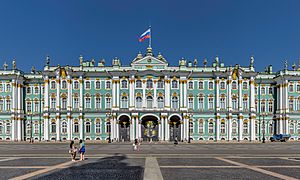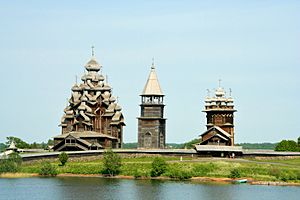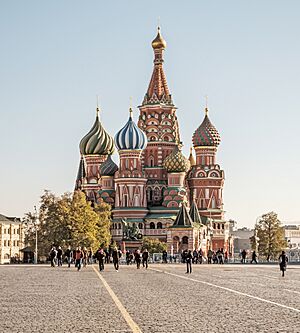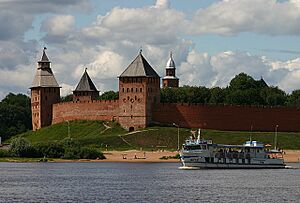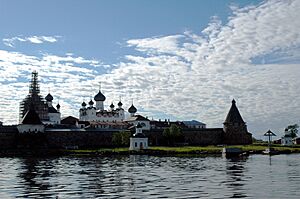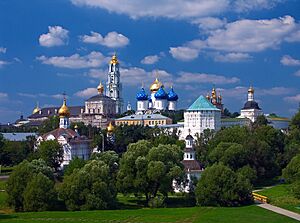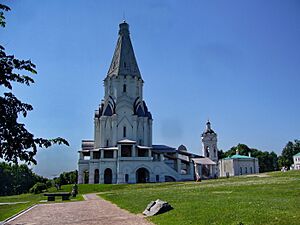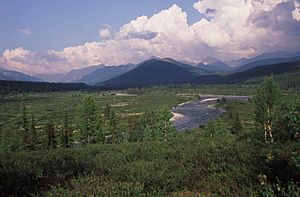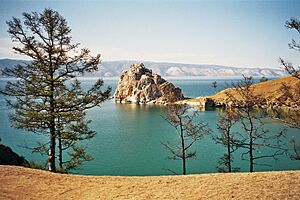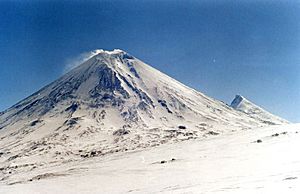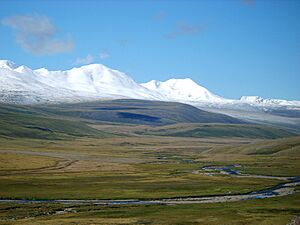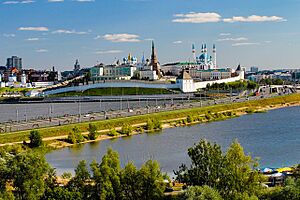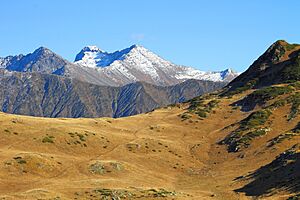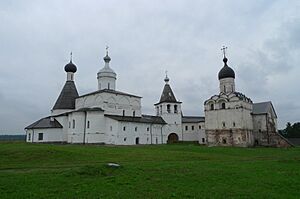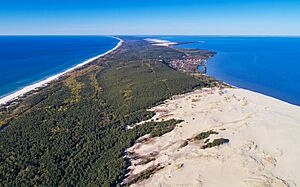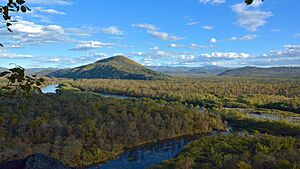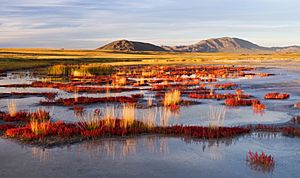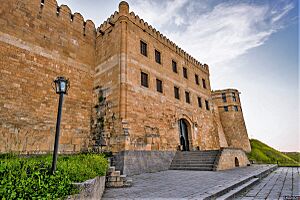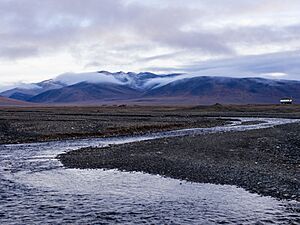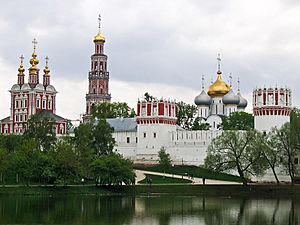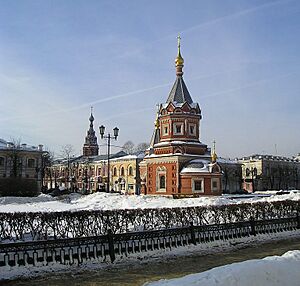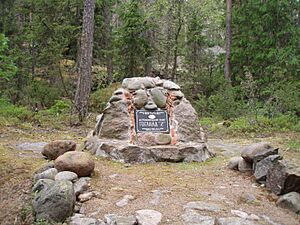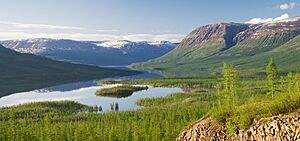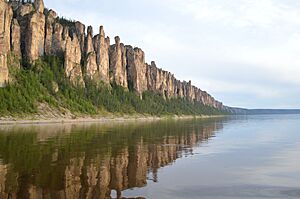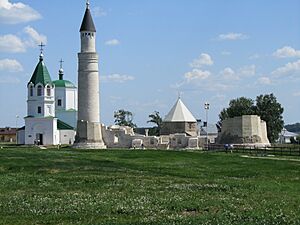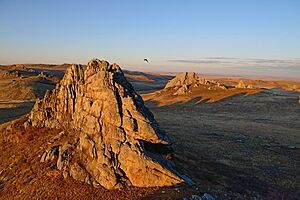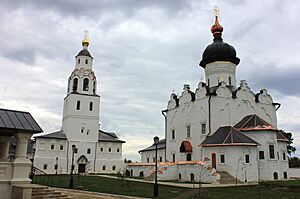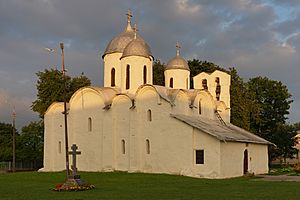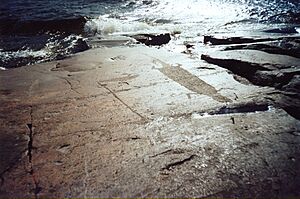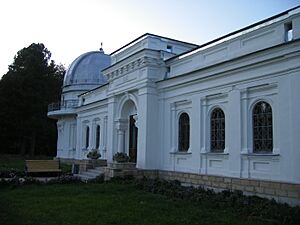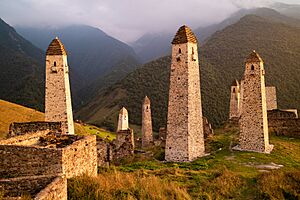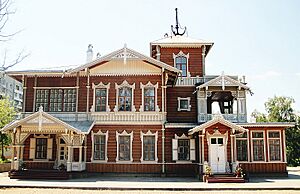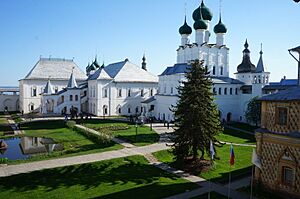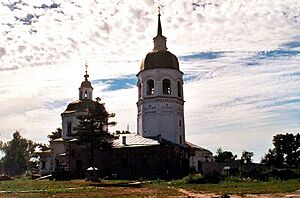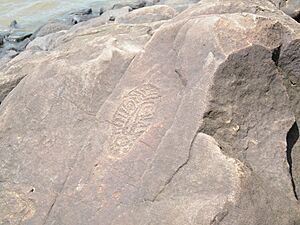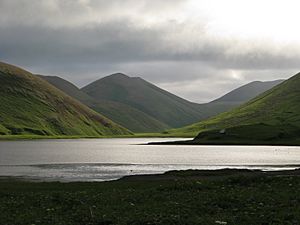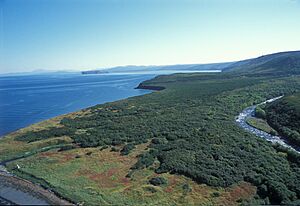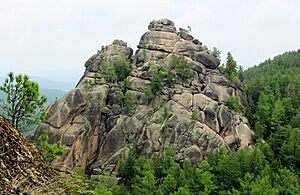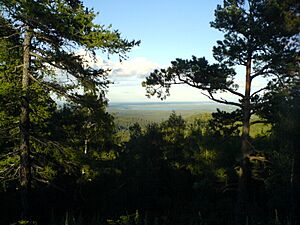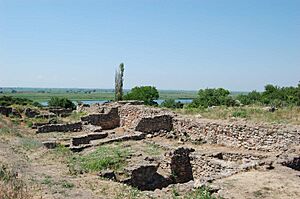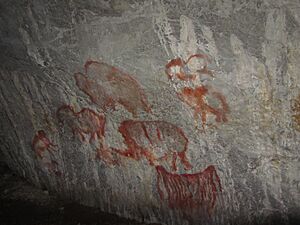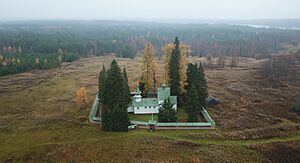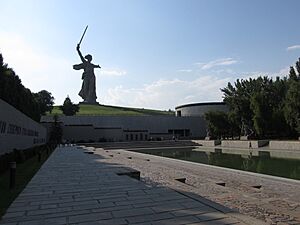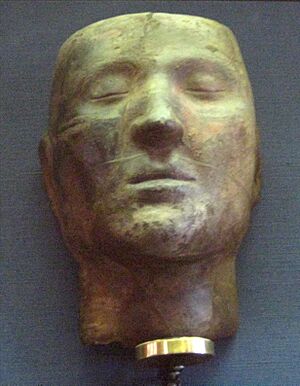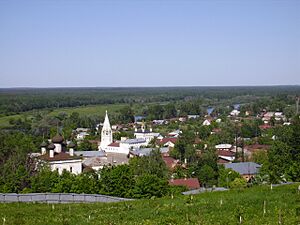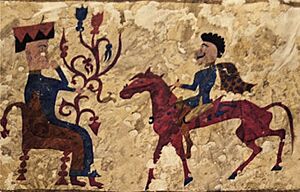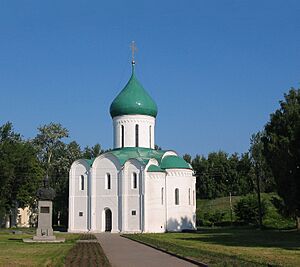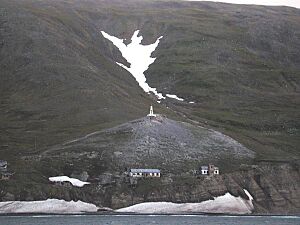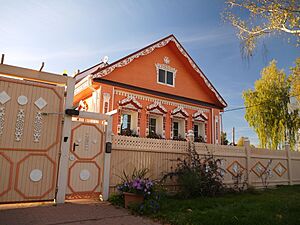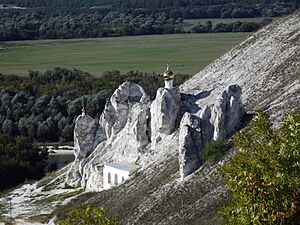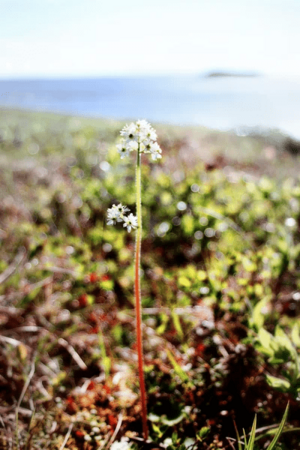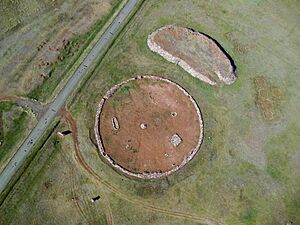List of World Heritage Sites in Russia facts for kids
The United Nations Educational, Scientific and Cultural Organization (UNESCO) helps protect special places around the world. These places are called World Heritage Sites. They are important for their culture or natural heritage. Cultural sites include amazing buildings, sculptures, or old ruins. Natural sites are special places like mountains, forests, or lakes that are important for science, nature, or beauty.
The Soviet Union, which included Russia, agreed to join this plan in 1988. The first five sites were added in 1990. Three of these first sites are in Russia today: the historic buildings of Saint Petersburg, Kizhi Pogost, and the Moscow Kremlin and Red Square.
As of 2022[update], Russia has 30 World Heritage Sites. There are also 28 more places on a "tentative list." These might become World Heritage Sites in the future. The newest site added was the Petroglyphs of Lake Onega and the White Sea in 2021. Russia has 19 cultural sites and 11 natural sites. Four of these sites are shared with other countries. For example, the Curonian Spit is shared with Lithuania.
Contents
Amazing World Heritage Sites in Russia
UNESCO chooses sites based on ten different rules. Each site must meet at least one of these rules. Rules 1 to 6 are for cultural sites, and rules 7 to 10 are for natural sites. * Shared with other countries
| Site | Image | Location | Year listed | UNESCO data | What Makes It Special |
|---|---|---|---|---|---|
| Historic Centre of Saint Petersburg and Related Groups of Monuments | Saint Petersburg | 1990 | 540; i, ii, iv, vi (cultural) | Tsar Peter the Great started building Saint Petersburg in the early 1700s. He wanted a new capital city and a port on the Neva River. The city was built on tough land, with marshes and rocks. This site includes the old city center with its beautiful Baroque and Neoclassical architecture. It also has palaces nearby, like those in Pushkin. Famous buildings include the Winter Palace (pictured), where the Hermitage Museum is now. | |
| Kizhi Pogost | Karelia | 1990 | 544; i, iv, v (cultural) | The Kizhi Pogost is a group of buildings on Kizhi Island in Lake Onega. It has two wooden churches from the 1700s and a clock tower from 1862. These buildings show amazing Russian carpentry skills. They have been repaired over time but still look much like they did when first built. | |
| Kremlin and Red Square, Moscow | Moscow | 1990 | 545; i, ii, iv, vi (cultural) | The Moscow Kremlin is the oldest part of Moscow, first mentioned in 1147. It was once the center of power and religion. Its walls and towers were built in the late 1400s and early 1500s. Churches inside, like the Assumption Cathedral, were designed by Italian architects. Saint Basil's Cathedral (pictured) is a famous church outside the Kremlin walls in Red Square. | |
| Historic Monuments of Novgorod and Surroundings | Novgorod Oblast | 1992 | 604; ii, iv, vi (cultural) | Novgorod was an important city in early Russia, starting in the 800s. It was a major trading hub connecting Northern Europe and Asia. The city became a center for Russian art, culture, and religion. Many old churches and monasteries from the 1100s to 1400s are still standing. The Kremlin (pictured) is a famous fortress here. | |
| Cultural and Historic Ensemble of the Solovetsky Islands | Arkhangelsk Oblast | 1992 | 632; iv (cultural) | These six islands in the White Sea have been lived on for thousands of years. A strong Solovetsky Monastery was built here in the 1430s. It was active until the 1920s when it became a prison camp. Today, it is back with the Orthodox church. The site includes the monastery, old villages, and prehistoric spots. | |
| White Monuments of Vladimir and Suzdal | Vladimir Oblast | 1992 | 633; i, ii, iv (cultural) | Vladimir and Suzdal were important towns in the 1100s and 1200s. This site includes monuments built in a special local style. Key buildings are the Cathedral of the Assumption in Vladimir and the Monastery of Our Savior and St Euthymius (pictured) in Suzdal. These show unique Russian architecture. | |
| Architectural Ensemble of the Trinity Sergius Lavra in Sergiev Posad | Moscow Oblast | 1993 | 657; ii, iv (cultural) | This monastery in Sergiev Posad is the most important Russian monastery. It is the spiritual heart of the Russian Orthodox Church. Founded in 1337, it grew over centuries. The Trinity Cathedral (1422) holds a famous icon. The Assumption Cathedral (1500s) has the tomb of Tsar Boris Godunov. Thick walls protected it during a siege in 1610. | |
| Church of the Ascension, Kolomenskoye | Moscow | 1994 | 634rev; ii (cultural) | The Church of the Ascension was built in 1532 to celebrate the birth of Ivan the Terrible. This church is special because of its stone tent-shaped roof. Before this, such roofs were only made of wood. This design greatly influenced Russian church architecture for many years. | |
| Virgin Komi Forests | Komi Republic | 1995 | 719; vii, ix (natural) | These untouched forests cover 32,000 square kilometers (about 12,355 square miles) in the Ural Mountains. They include taiga (boreal forest), tundra, and alpine tundra. You'll find many conifer, aspen, and birch trees here. There are also large peatlands. | |
| Lake Baikal | Irkutsk Oblast, Buryatia | 1996 | 754; vii, viii, ix, x (natural) | Lake Baikal is the deepest lake in the world, reaching 1,700 meters (about 5,577 feet) deep. It holds about 20% of the world's fresh water that isn't frozen. It's also the oldest lake, at 25 million years old. Because of its unique features, it has many special plants and animals found nowhere else. | |
| Volcanoes of Kamchatka | Kamchatka Krai | 1996 | 765bis; vii, viii, ix, x (natural) | The Kamchatka Peninsula has many active volcanoes and volcanic features. There are also many glaciers. This area is home to animals like the sea otter, brown bear, and Steller's sea eagle. Rivers here are important places for salmon to lay their eggs. The site was expanded in 2001 to include six areas. The Klyuchevskaya Sopka volcano is pictured. | |
| Golden Mountains of Altai | Altai Republic | 1998 | 768rev; x (natural) | This site includes the Altai and Katun Natural Reserves, Lake Teletskoye, Belukha Mountain, and the Ukok Plateau. It's important for its wide range of plants, from steppe to alpine vegetation. It is also home to the rare snow leopard. | |
| Historic and Architectural Complex of the Kazan Kremlin | Tatarstan | 2000 | 980; ii, iii, iv (cultural) | Tsar Ivan the Terrible took the city of Kazan in 1552. He built the Kremlin on the site of an older Tatar fortress. The buildings, mostly from the 1500s to 1800s, show a mix of Russian and Tatar styles. They also show Christian and Muslim influences. The Kul Sharif Mosque is a newer building on the site of an older mosque. | |
| Western Caucasus | Krasnodar Krai | 1999 | 900; ix, x (natural) | This site includes seven areas in the western Caucasus mountains. These are some of the few mountain forest areas that humans have not changed much. They have many different ecosystems, from lowlands to high mountain zones. They are home to many animal and plant species. The European bison has also been brought back to this area. | |
| Ensemble of the Ferapontov Monastery | Vologda Oblast | 2000 | 982; i, iv (cultural) | Saint Ferapont founded this monastery in 1398 in a remote part of northern Russia. The buildings are from the 1400s to 1600s. The monastery is a great example of a Russian Orthodox monastery from that time. The Cathedral of the Nativity of the Virgin has famous frescos by the artist Dionisius. | |
| Curonian Spit* | Kaliningrad Oblast | 2000 | 994; v (cultural) | The Curonian Spit is a 98-kilometer (about 61-mile) long sandy strip of land. It separates the Curonian Lagoon from the Baltic Sea. People have lived here since ancient times. In the 1600s and 1700s, too much logging caused the sand dunes to move. Work to stabilize the dunes started in the 1800s and continues today. This area is also important for its unique plants and animals, and as a bird migration route. Part of the Spit is in Lithuania. | |
| Central Sikhote-Alin | Primorsky Krai | 2001 | 766bis; x (natural) | This site includes three areas in the Sikhote-Alin mountains. The forests here are a special mix of taiga and subtropical plants. They are home to animals like the Siberian tiger, Himalayan black bear, and sable. The Bikin River Valley was added to the site in 2018. | |
| Uvs Nuur Basin* | Tuva | 2003 | 769rev; ix, x (natural) | This site is shared with Mongolia. It includes seven areas in Russia and five in Mongolia. The Uvs Nuur Basin is a large area that drains into the shallow, salty Uvs Lake. It has many different habitats, like wetlands, steppes, forests, and mountain tundra. Many bird species, the snow leopard, and other animals live here. | |
| Citadel, Ancient City and Fortress Buildings of Derbent | Dagestan | 2003 | 1070; iii, iv (cultural) | Derbent is the oldest city in Russia. It sits on a narrow plain between the Caspian Sea and the Caucasus mountains. Because of its important location between Europe and Asia, defensive walls were built here thousands of years ago. Two parallel walls from the 400s and 500s CE still stand today. The city was shaped by many different rulers over time. | |
| Natural System of Wrangel Island Reserve | Chukotka Autonomous Okrug | 2004 | 1023rev; ix, x (natural) | Wrangel Island is in the Arctic Ocean. It was not covered by ice during the last Ice Age. This means it has many plant types that disappeared elsewhere in the Arctic. It also has the most different kinds of plants and animals of all Arctic islands. It was the last place where woolly mammoths lived. The island is home to seabirds, snow geese, and a huge walrus colony. It's also a feeding ground for gray whales. | |
| Ensemble of the Novodevichy Convent | Moscow | 2004 | 1097; i, iv, vi (cultural) | This monastery was founded in the 1520s. Its buildings, from the 1500s and 1600s, show the popular Muscovite Baroque style. It was closely connected to the royal family. Many noble women became nuns here, and it was a burial place for nobles. The convent's walls were part of Moscow's defenses. | |
| Historical Centre of the City of Yaroslavl | Yaroslavl Oblast | 2005 | 1170; ii, iv (cultural) | The city of Yaroslavl is where the Volga and Kotorosl rivers meet. It started as a small wooden fort in the 1000s. It grew into a major trading center after 1463. Many churches from the 1500s and 1600s are still here. In the late 1700s, Empress Catherine the Great had the city center redesigned in a Neoclassical style. | |
| Struve Geodetic Arc* | Leningrad Oblast | 2005 | 1187; ii, iii, vi (cultural) | The Struve Geodetic Arc is a chain of survey points that stretches 2,820 kilometers (about 1,752 miles) across Europe. These points were used by astronomer Friedrich Georg Wilhelm von Struve to accurately measure the Earth's size and shape. The World Heritage Site includes 34 points in ten countries. Two of these points are in Russia, on the island of Gogland. | |
| Putorana Plateau | Krasnoyarsk Krai | 2010 | 1234rev; vii, ix (natural) | The Putorana Plateau is in northern Siberia. It is mostly made of basalt rock. This remote and untouched area has many different ecosystems, like taiga, tundra, and Arctic deserts. It's a major route for reindeer migration. | |
| Lena Pillars Nature Park | Sakha | 2012 | 1299bis; viii (natural) | The Lena Pillars are tall rock formations, up to 200 meters (about 656 feet) high, along the Lena River. They were formed by freezing and thawing over millions of years. The pillars are made of very old rocks from the Cambrian period. These rocks contain fossils that show how early life forms developed. | |
| Bolgar Historical and Archaeological Complex | Tatarstan | 2014 | 981rev; ii, vi (cultural) | Bolghar was the capital of Volga Bulgaria, a state that existed from the 600s to 1400s. After the Mongol invasion in the 1200s, it became an early capital of the Golden Horde. It remained an important trading center. Islam became the official religion here in 922. Today, Bolghar is still a holy place for Volga Tatars. | |
| Landscapes of Dauria* | Zabaykalsky Krai | 2017 | 1448rev; ix, x (natural) | Dauria is a region east of Lake Baikal. This site is shared with Mongolia. It includes different steppe ecosystems, forests, grasslands, wetlands, and lakes. The area is important for many bird species, like the white-naped crane. It's also a migration area for the Mongolian gazelle. | |
| Assumption Cathedral and Monastery of the town-island of Sviyazhsk | Tatarstan | 2017 | 1525; ii, iv (cultural) | This town-island was founded in 1551 by Ivan the Terrible. It was in a key spot where three rivers met, important for trade and for Ivan's conquest of Kazan. The cathedral and monastery were built in the 1500s. The frescos inside the cathedral are some of the best examples of Russian Orthodox paintings. | |
| Churches of the Pskov School of Architecture | Pskov Oblast | 2019 | 1523; ii (cultural) | This site includes ten churches and monasteries in the city of Pskov. They show the unique style of the Pskov School of Architecture. This style mixed old traditions with local building methods. The churches date from the 1100s to early 1600s. Architects from Pskov also worked on buildings in other Russian cities. The Cathedral of St. John from the 1100s is pictured. | |
| Petroglyphs of Lake Onega and the White Sea | Karelia | 2021 | 1654; iii (cultural) | This site has ancient rock carvings, called petroglyphs, in two areas. The carvings at Lake Onega show birds, animals, and strange half-human, half-animal figures. Those at the White Sea show hunting and sailing scenes. They were made 6,000 to 7,000 years ago. They give us a look into the lives of people from the Neolithic Age in this region. | |
| Astronomical Observatories of Kazan Federal University | Tatarstan | 2023 | 1678; i, ii, iv, vi (cultural) | This site includes two old astronomical observatories. One was founded in the early 1800s at Kazan Federal University. The other, at Engelhardt (pictured), started in 1901. Scientists used them to map stars and planets. They also used them to create new tools for studying space. |
Future World Heritage Sites: Tentative List
Countries can suggest sites they think should become World Heritage Sites. This is called a "tentative list." A site must be on this list before it can be officially nominated. As of 2022[update], Russia has 28 sites on its tentative list.
| Site | Image | Location | Year listed | UNESCO criteria | What Makes It Special |
|---|---|---|---|---|---|
| Historical and Cultural Jeyrakh-Assa Reservation | Ingushetia | 1996 | (cultural) | This area has 18 old settlements in mountain canyons. They are known for their stone towers (towers in Erzi pictured). These towers were used as homes and for defense. Most were built in the 1500s and 1600s. | |
| Historic Centre of Irkutsk | Irkutsk Oblast | 1998 | (cultural) | Irkutsk is a city near Lake Baikal. It was founded in 1661 as a military fort. Many exiles were sent here after a revolt in 1825. The city has many old buildings, including traditional decorated wooden houses (example pictured) and buildings in the Siberian Baroque style. | |
| Rostov Kremlin | Yaroslavl Oblast | 1998 | ii, iii, iv, vi (cultural) | The Kremlin in Rostov overlooks Lake Nero. It was built in parts and then joined together in the 1600s. It has a Metropolitan residence, several churches, and high walls. It is one of the best-preserved examples of old Russian architecture. | |
| Historic Center of Yeniseysk | Krasnoyarsk Krai | 2000 | ii, iii, iv (cultural) | The town of Yeniseysk was founded in 1619. It was a base for Russia's expansion into East Siberia. Located on the Yenisey River, it was also an important trading center. Many buildings from the 1700s and 1800s are still preserved. The Monastery of the Transfiguration of the Savior is pictured. | |
| Petroglyphs of Sikachi-Alyan | Khabarovsk Krai | 2003 | (cultural) | These ancient rock carvings, or petroglyphs, are found on cliffs above the Amur River. They are near the village of Sikachi-Alyan. They were first noticed in the late 1800s and studied more in the 1900s. | |
| The Commander Islands (Comandorsky State Nature Reserve) | Kamchatka Krai | 2005 | vii, viii, ix, x (natural) | This nature reserve includes two large islands (Bering Island and Medny Island, pictured), smaller islands, and the surrounding waters. These islands are important homes for many birds and sea mammals. | |
| Magadansky State Nature Reserve | Magadan Oblast | 2005 | vii, viii, ix, x (natural) | This reserve has four parts. Three are near the coast of the Sea of Okhotsk, and one is further inland. The climate here is very cold. The forests are mostly conifers, and there are unique plant species. The rivers are vital for migrating salmon. | |
| Krasnoyarsk Stolby | Krasnoyarsk Krai | 2007 | vii, viii, ix, x (natural) | The "stolby" (meaning rocks) are large rock formations in the Eastern Sayan Mountains. These rocks are very old and contain fossils. The area is popular for rock climbing. | |
| The Great Vasyugan Mire | – | Tomsk Oblast | 2007 | vii, viii, ix, x (natural) | The Vasyugan Mire is the largest swamp in the Northern Hemisphere. It has peat bogs, fens, and forested mires. This swamp supports many insects, which feed many migrating and nesting birds. Animals like elk, brown bear, and lynx also live here. |
| Ensemble of the Astrakhan Kremlin | Astrakhan Oblast | 2008 | ii, iii, iv (cultural) | After Ivan the Terrible conquered Astrakhan, its kremlin was built in 1558. It was first made of wood, then stone. It served as a strong fort on Russia's southeastern border and a stop on the Silk Road. The Assumption Cathedral (pictured) is a beautiful example of 18th-century Russian church architecture. | |
| The Ilmensky mountains | Chelyabinsk Oblast | 2008 | vi, vii, viii (natural) | These mountains have rich deposits of many different minerals. Some minerals were first found here. The area is protected as the Ilmen Nature Reserve and is usually closed to the public. | |
| The archeological site of Tanais | Rostov Oblast | 2009 | ii, iii, v (cultural) | Tanais was an ancient Greek colony founded in the 200s BCE. It was a strong trading center where Greeks and nomadic tribes met. The city was burned down in the 200s CE, possibly by the Goths. | |
| Bashkir Ural | Bashkortostan | 2012 | i, iii, v, vi, viii, x (mixed) | This area in the southern Ural Mountains is important for both nature and culture. It has many different plants and animals, as it's where European and Asian forests and steppes meet. There are also caves, including Kapova Cave (pictured) with ancient cave paintings from the Paleolithic Age. The Bashkirs people who live here still practice old traditions, like wild beekeeping. | |
| Testament of Kenozero Lake | Arkhangelsk Oblast | 2014 | iii, iv, v, vi, vii (mixed) | This national park shows a landscape shaped by farmers over centuries, from the 1100s to 1500s. It has taiga forests and several lakes. There are many wooden churches (St. George's church pictured), chapels, and holy crosses. | |
| Virgin Komi Forests (re-nomination) | Komi Republic | 2014 | vii, viii, ix, x (natural) | This nomination suggests changing the borders of the existing World Heritage Site. It also provides more reasons why it is a special natural place. | |
| Western Caucasus (re-nomination) | Krasnodar Krai | 2014 | ix, x (natural) | This nomination suggests changing the borders of the existing World Heritage Site. | |
| Mamayev Kurgan Memorial Complex "To the Heroes of the Battle of Stalingrad" | Volgograd Oblast | 2014 | i, iv, vi (cultural) | This complex in Volgograd (formerly Stalingrad) honors those who died in the Battle of Stalingrad during World War II. It was built from 1959 to 1967. It has stairs, halls, and a huge statue called The Motherland Calls (pictured). | |
| The Oglakhty Range | Khakassia | 2016 | i, iii, vi, x (mixed) | The Oglakhty mountain range is on the Yenisei river. People have lived here for at least 5,000 years. Different cultures left behind archaeological remains, like petroglyphs and burial sites. The landscape has untouched forests and steppes with diverse plants and animals. | |
| Historic Centre of Gorokhovets | Vladimir Oblast | 2017 | ii, iv (cultural) | The town of Gorokhovets was founded in the 1100s. It was built to protect the southern border of Vladimir-Suzdal. The town had its best times in the 1600s and 1700s as an important trading center. Many churches and monasteries from that time are still standing. | |
| Treasures of the Pazyryk Culture | Altai Republic | 2018 | i, ii, iii, vi (cultural) | This nomination includes sites from the Pazyryk Culture. This was a nomadic culture from the 500s to 100s BCE. Discoveries include petroglyphs, burial mounds with preserved mummies, and old textiles (carpet pictured). | |
| Rock Painting of Shulgan-Tash Cave | Bashkortostan | 2018 | i, iii (cultural) | The cave paintings in Shulgan-Tash, or Kapova Cave, are from the Upper Paleolithic period. They were made with red ochre and show mammoths, woolly rhinoceroses, and horses. People lived in the cave for thousands of years, likely for special ceremonies. It was rediscovered in the mid-1900s. | |
| Cathedral of the Transfiguration of the Savior with the Medieval Rampart City Wall of Pereslavl-Zalessky (1152-1157) | Yaroslavl Oblast | 2019 | i, ii, iv (cultural) | The Transfiguration Cathedral is the oldest example of Russian white-stone architecture. Its design was influenced by Western European and Byzantine styles. The town of Pereslavl-Zalessky was founded in 1152. It was surrounded by earthen walls, which are still here today. | |
| Heritage of Chukotka Arctic Marine Hunters | Chukotka Autonomous Okrug | 2019 | ii, iii, v, vi (cultural) | This nomination includes three sites related to the Siberian Yupik (Eskimo) people. They lived in the far north of Chukotka. The sites show tools, hunting weapons, and jewelry made from animal bones. These hunters mainly focused on marine mammals. | |
| Vyatskoe village | Yaroslavl Oblast | 2019 | ii, v (cultural) | The village of Vyatskoe was first mentioned in 1502. It grew mostly in the 1700s. Its architecture, including merchant and peasant houses, churches, and public buildings, is well preserved. Villagers still practice traditional crafts, like making pickled cucumbers. | |
| Divnogorye Historical and Cultural Complex | Voronezh Oblast | 2020 | ii, iv, v, vi (cultural) | Divnogorye is a chalk and limestone landscape along the Don river. People have lived here since the Upper Paleolithic Age. In the 700s and 800s, it was a fortified settlement. In the 1700s and 1800s, hermits carved caves and churches into the soft rock (Cave monastery of St. John the Baptist pictured). | |
| National Park Kytalyk | Sakha | 2021 | ix, x (natural) | Kytalyk National Park covers parts of the Kolyma Lowland and Yana-Indigirka Lowland. It is a tundra landscape with unique features like polygonal soils and pingoes. The park is home to the endangered Siberian crane and many species of ducks and geese. | |
| Valley of the Kings of Tuva | Tuva | 2021 | i, iii, iv (cultural) | The Uyuk river valley has thousands of burial mounds, called kurgans. They are made of stone or earth and date back to the 1st millennium BCE. These are from the early Scythian cultures. Archaeologists have found thousands of gold objects in Arzhaan-2 (pictured from above), which are now in museums. |
See also
 In Spanish: Anexo:Patrimonio de la Humanidad en Rusia para niños
In Spanish: Anexo:Patrimonio de la Humanidad en Rusia para niños
- List of World Heritage Sites in the Soviet Union
- Tourism in Russia


